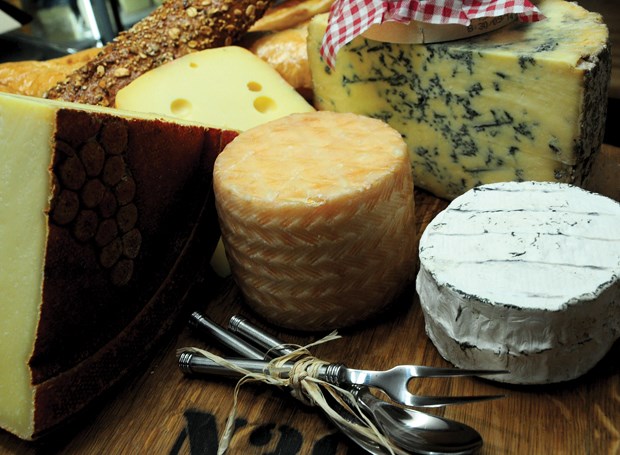For more than three decades, a small shop in the industrial strip behind Capilano Mall has quietly championed fine cheeses to a steadily growing North Shore audience.
After frequenting the store for 15 years as an enthusiastic and loyal customer, Doug Martin, unfulfilled by a career in the corporate world, made a life-altering decision and bought the shop when it was put up for sale six years ago.
If you live on the North Shore, have even the faintest appreciation for cheese that does not come in an aerosol can, but have not yet visited The Cheese Man, you owe it to yourself to check it out.
Martin prides himself on cultivating the palates of his customers, a passionate community of cheese enthusiasts that follow with eager anticipation the arrival of exciting new and unusual products. I recently spent a morning with Martin in his shop to discuss his concurrent duties as cheese wholesaler, retailer, educator, researcher and tireless aficionado.
As I walked into the shop my senses were immediately awakened by a burst of complex aromas; Martin had laid out a selection of notable cheese for me to sample, spanning a wide geography and broad flavour spectrum.
Exercising unusual restraint, I opted to query Martin prior to sampling the enticing spread. The world of cheese, much like the world of wine so often associated with it, is a storied and fascinating one, with unique histories, legends and lore that help explain the fiercely protected regional designations that many cheese labels bear.
Martin explains, for example, that the centuries-old practice of using ash to ripen cheese may have originally come about as a way for farmers to avoid some of the burdensome taxes levied on them by landowners; burying their cheeses in ash helped farmers to disguise the true volume of their output. As it happens, ash also served to protect the vulnerable surfaces of young cheeses from harmful microbes while allowing the product underneath to suitably ripen.
Transmitting knowledge about the products he sells to customers based on their individual palates in order to foster a greater appreciation for artisanal cheese is Martin’s life work and a key factor that distinguishes his business from what he calls the “grab and go” approach of big corporate stores.
Many new grocers supply a wide selection of cheeses but fail to engage with the consumer, leaving novice palates to fend for themselves and possibly miss the mark with their cheese purchases. I am reminded of the first time I bought a wedge of blue cheese when I was in my early teens.
I was keen to understand what others appreciated about it and, without guidance, chose a potent, aged, Spanish blue goat’s cheese called Cabrales; it was overwhelmingly intense and put me off trying other blues for a few years.
“That’s because your palate wasn’t ready for it,” Martin explains. “If you had been guided along a more gradual path, you would have progressed to a place where that potent cheese was more approachable to you.”
I have to concede the point as I now relish bold blue cheeses above most others, but recognize that it has taken me two decades to get here.
My tasting begins with raclette, a semi-firm cow’s milk cheese from Switzerland with a pungent nose but decidedly mild flavour and silky texture.
Raclette, a cold-weather cheese popular with alpine hikers, is traditionally served from a specialized apparatus that gently melts the cheese, allowing it to be scraped into bite-sized dollops that can be applied to bread, potatoes, and other vessels. Martin rents the raclette device to interested customers in order to uphold the unique seasonal tradition.
Another highlight of my tasting was Piave Vecchio, a firm and sharp, Parmesan-like Italian cheese suitable for consumption on its own or grated overtop foods. Martin served the cheese in thin shavings that melted in the mouth, revealing nutty flavours and a distinct, almost crystalline texture.
The cheese would marry exceptionally well with the firm but elegant red wines of Piedmont, especially a good quality Barbera.
Also of note in the tasting was a complex and intense Gouda, aged for 48 months. The rock-hard cheese, crumbly and mocha-hued, was like dessert in its own right, with lush flavours of butterscotch and salted hazelnuts.
We finished with one of my personal favourites, Fourme D’Ambert, a richly creamy, earthy blue. Its reserved sharpness makes it a dangerous gateway blue cheese, so accessible to those keen to explore blue cheeses further that it is likely to prompt them to seek bolder incarnations.
It is worth noting that as a wholesaler, Martin is able to sell his cheeses at prices considerably lower than the average retailer.
The Cheese Man is closed on Sundays and Mondays and accepts cash payment only. The shop is located at 991 West Third St. in North Vancouver. cheeseman.ca
Chris Dagenais served as a manager for several restaurants downtown and on the North Shore. A self-described wine fanatic, he earned his sommelier diploma in 2001. Contact: [email protected].



